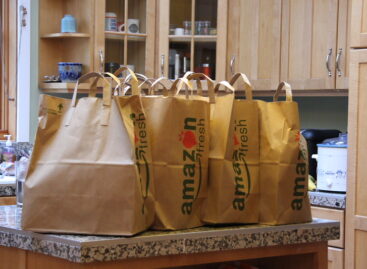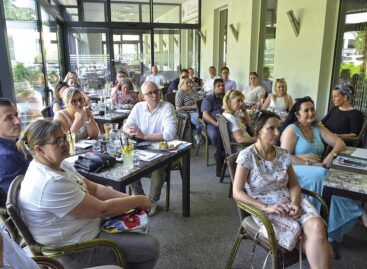Market Researchers about the last 15 months
 As in previous years, this year’s leading market researchers analyzed the past 15 months at the Trade Marketing Club’s April 7 online event.
As in previous years, this year’s leading market researchers analyzed the past 15 months at the Trade Marketing Club’s April 7 online event.
Nearly 100 people have registered for the Microsoft Teams video conferencing platform, as changes in customer behavior, channel and chain preferences, promotions, brand acceptance, digital innovations, sustainability requirements and the consequences of current events raise many questions.
We’re rearranging… again

Tünde Turcsán, Business Unit Director of GfK FMCG, began his presentation with an overview of the current situation. He reviewed the behavioral effects of the pandemic, which, in addition to state of mind and activities, also resulted in large and seemingly lasting changes in shopping habits. In the covid years, FMCG sales increased, but the frequency of purchases decreased. The popularity of discounters is unbroken, and in the period of January-February 2022, their turnover share increased further and they have already become places for daily shopping. The online channel is moving forward with double-digit growth, already slicing around 2% from the daycare market.
Through the results of a recent representative survey of 1,000 people, the speaker also showed that Hungarian shoppers are open to innovation, including innovations related to online shopping, chain applications and payment habits. Providing a shopping experience in virtual reality, even on the screen of mobile phones, is a requirement, the lack of which deters many from e-commerce. Customers are familiar with the top5 retail app, but only half and a quarter use it regularly. Credit card payments have now bypassed cash, and more and more people are using mobile phones for this purpose. The popularity of the alternatives for receiving the ordered goods is determined by the possibility of keeping the food fresh.
FMCG market overview

Csilla Czikora, NielsenIQ’s Customer Relations Director, reviewed the key trends of 2021 and future expectations. Analyzing the dynamics of the FMCG market, he noted that the slowdown in volume growth also indicates that consumers are perceiving an increase in the price level, so that price has again become a determining factor. The recovery at the beginning of the year is driven by the change in price levels. Consumer preferences have changed, so it is worthwhile for manufacturers and traders to focus on the most important product features for consumers in both the food and chemical categories.

Gergő Kovács, Business Partner of NielsenIQ Client, examined the changes in shopping habits in terms of changes in store selection and reactions to rising prices. He highlighted that 4 of the top7 store selection criteria are related to price. The Central and Eastern European region and Hungary are particularly characterized by price and promotion sensitivity, with three-quarters of buyers searching and buying based on this. Looking to the future, the fact that two-thirds of customers worldwide have re-evaluated their priorities has changed their habits. Inflation may be offset for some time by the fact that many people spend PIT refunds to cover everyday needs. The complex picture is further nuanced by current events and challenges, which can be prepared for by considering risk reduction options.
A Sudden Shift in Behavior

Andreas Christou, CEO of RetailZoom, reviewed 2021 and the first quarter of this year in terms of domestic chains. The double-digit growth is typical for the sector as a whole and for the top3 players separately. The impulse buying that has slowed down in the covid years has returned to these stores, so small packs and pampering products are on sale again. The beer category regained its second place in 2019, so it follows the meat products in the rankings. The sales figures show the strengthening of the own brand, which will continue to be typical.
Analyzing the first 3 months of 2022, it turned out that with increasing basket value, the number of products placed in the basket decreased and the scissors are expected to open further. By segmenting customers, it has become apparent that convenience and top-up baskets have grown in this sector, meaning a shift towards several times fewer purchases.
Among domestic channels, the most growing FMCG traffic was measured in traffic. 10% of shoppers here do not even have a tobacco product in their basket, and 70% of their baskets buy mixed. For certain categories, tobacco shops have become an unavoidable and growth generator.
Online Retail Big Picture

Norbert Madar, Senior Consultant at gkid Research & Consulting, also looked at the effects that shape the development of trade. Although the online sector can be considered a clear winner and beneficiary in recent years, the outcome of the future will be affected by many factors. The share of e-commerce is close to 20% worldwide and has exceeded the 10% threshold in Hungary as well, making it unstoppably on the commercial palette. In the initial period, the co-movement of online and offline commerce was typical, but from the spring of 2020, the opposite trend was observed. The frequency of online shopping is constantly increasing, this year it can be expected to be 19-20 times a year / person, which stimulates spending.
When reaching the target group, it is worth considering the available age and demographic composition data. FMCG has become the fastest growing online category, growing far above the market average.
More about the lectures in Trade magazine 2022 / 6-7. will be available in print.
The professional partner of the conference:

Related news
Records and innovations
🎧 Hallgasd a cikket: Lejátszás Szünet Folytatás Leállítás Nyelv: Auto…
Read more >AI will accelerate the end of brick and mortar’s reign: Amazon CEO
🎧 Hallgasd a cikket: Lejátszás Szünet Folytatás Leállítás Nyelv: Auto…
Read more >A net, not a network: the art of networking
🎧 Hallgasd a cikket: Lejátszás Szünet Folytatás Leállítás Nyelv: Auto…
Read more >Related news
2026 begins in agriculture amid crises and a wave of investment – banking focuses on the dairy and pig markets, as well as CAP investments
🎧 Hallgasd a cikket: Lejátszás Szünet Folytatás Leállítás Nyelv: Auto…
Read more >Sovereignty Protection Office: According to the public, there is no place for foreign majority ownership in strategic sectors
🎧 Hallgasd a cikket: Lejátszás Szünet Folytatás Leállítás Nyelv: Auto…
Read more >Poor fruit harvest weighs on the pálinka sector
🎧 Hallgasd a cikket: Lejátszás Szünet Folytatás Leállítás Nyelv: Auto…
Read more >







